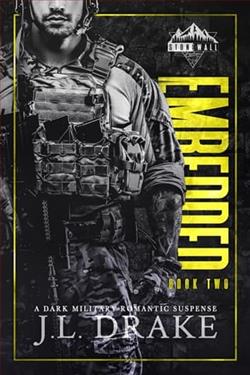Page 6 of The Watchmaker's Hand
Six feet away from the lifesaving gap, the mast suddenly pitched forward a few feet. Garry slipped from the seat and fell. He landed face-first on the bulb of the window. From here, he found himself looking straight downward, twenty-two stories, to the jobsite. He inhaled and exhaled deeply, leaving a design of condensation on the glass in front of him. It was, curiously, almost in the shape of a heart.
He thought of his wife.
And of their child, soon to be born.
Kierkegaard or Bashilda …
2.
AT SOME POINT,an open investigation slips over an unseen border and becomes a cold case.
Who knows what the time frame is? Some cops might say a year, some might say a decade.
Lincoln Rhyme didn’t like the phrase. It suggested that the offense had been seized on by podcasters and documentary TV show producers to sell the ever-popular tale of an evildoer escaping justice.
The unsolved cases that drew the most attention were murders, of course. The spouse that went missing, the mafioso snitch, the abusive father who has “no idea” where his young son wandered off to. No one paid much attention to unsolved larcenies—other than the spectacular: the diamond heist, the armored truck stickup, the parachuting from a Boeing 727 with $200K in ransom (and whereareyou, D. B. Cooper?).
To Rhyme, an unsolved case was merely an unsolved case, whether twenty-four hours or one hundred years old, and itabsolutely needed to be closed, larcenies included. Which was what was presently occupying much of his time.
This one was a few months old and the inability to solve it was giving Rhyme—and the NYPD and Homeland Security—more than a little concern.
A person they’d designated “Unknown Subject”—Unsub 212—had on February 12 (hence, the moniker) broken into the NYC Department of Structures and Engineering and downloaded a trove of infrastructure documents: blueprints, engineering diagrams, underground maps, plats, permit requests—all the bits and bytes of material involved in the gargantuan process of helping the organism of New York City grow and morph. To be safe, maybe, the unsub had also copped hundreds of hard copies of the same and other documents, maybe in case some of the digital files were encrypted.
At the time of the theft, everyone thought:Terrorism. Always a good default motive for a crime of this sort. Bombs would be planted, subways hijacked, buildings targeted with missiles or airplanes.
Rhyme and his wife and professional forensic partner, Amelia Sachs, had been brought in to try to identify the unsub via forensics. Despite the man’s accidentally setting off an alarm and fleeing, leaving his burglar tools behind, they could come up with no leads. The city remained on high alert for a while, but no terrorist attacks ensued.
And so, Unsub 212’s theft remained an active case, and his nickname was atop the evidence whiteboard in the corner of the parlor of Rhyme’s nineteenth-century town house, the war room for the cases he and Sachs ran—she, as an NYPD detective, and he, a consulting forensic scientist. The boards were known throughout law enforcement as “murder boards,” though this one offered details of a theft instead; there’d been no loss of life or injury in the incident. Rhyme and Sachs had turned their attentionaway from the case temporarily—to a couple of urgent organized crime prosecutions, but those were now finished. There was nothing more to do than wait to testify at trial as an expert witness—either at one or the other, of course, never together; defense lawyers would have a field day inquiring about the relationship status of the two. There was not, legally, any reason they could not testify jointly, but criminal trials are about four things: optics, optics, optics … and then the law.
So now it was back to the open—not “cold”—Unsub 212 case.
Rhyme aimed his motorized wheelchair toward the board. Injured on a crime scene years ago, rendered a quadriplegic, the former head of NYPD forensics was always searching out any medical treatments that might improve his condition. While there was no way, yet, to restore sensation below his neck, complicated procedures involving surgery and prosthetics had restored most movement to his right arm, which he exercised regularly. The chair, quite the “miracle of mobility,” the literature declared, could also be deftly operated by his left ring finger, the one appendage that had escaped the consequences of the catastrophic accident.
The human body is nothing if not an assembly of marvels and flukes.
Sachs was reading out loud a report from the Major Cases detective in charge of the 212 case. “No persons of interest on the city payroll,” she announced. She went on to explain that the officer had been interviewing employees of the DSE, thinking that it might be an inside job, as intangible property thefts often were when hackers were not involved. There was a video of the thief physically breaking into the server room, where he downloaded the files on a hard drive. It was clever: these days everyone protected against those sharp and bored Eastern European and Chinese hackers, but physically guarding data on-site lagged.
There was a video too of the unsub leaving the building. Itcame to Rhyme and the investigators via the city’s Domain Awareness System.
Aka, according to some civil libertarians, Big Brother.
The New York Police Department’s DAS was a network of twenty thousand CCTV video cameras around the city. The system collected and stored video and data from a wealth of information: license plate readings, summonses, recordings of 911 calls, complaints, officers’ reports, warrants and arrest notices. The entries numbered in the billions.
One of the DAS cameras had caught Unsub 212 walking out of the Engineering building, then disappearing around the corner. The alarm would be blaring, but he maintained a normal pace so as not to draw attention to himself.
How helpful was the vid? That was another matter. It recorded dark clothing, a hat. Head down, of course.
Rhyme’s assessment: useless, other than offering the man’s body build. Medium. A fact that was, he reflected, more or less useless too.
He glanced into the western portion of the parlor, where the lab was located behind a wall of floor-to-ceiling glass, sealed against contamination. Past the instruments and workstations—the envy of small- or even some medium-sized police labs—were brown shelves holding cataloged evidence. His eyes were on the small red plastic tool kit 212 had left behind when, after he’d gotten what he wanted, he’d had to flee.
They’d examined the box when the lead detective first brought it in and had done a thorough job. But, to Rhyme’s irritation, it had yielded no fingerprints, DNA or other trace. This was also a surprise. Evidence that’s abandoned quickly tends to be the most helpful—not, for instance, wiped clean of prints.
Sachs’s hands went to her trim hips, in black jeans, and, head tilted, her long dark red hair fell straight down, plumb. “What was he after?”
The key question, of course.
Motive is irrelevant in a trial and Rhyme didn’t particularly care for the topic during the investigation either, preferring evidence as the arrow that might point to the perp. Yet, ever skeptical Rhyme had to admit that, absent solid forensics, discovering a motive might lead you to a helpful location or even perps themselves. His metaphor in class: motive might give you the neighborhood, and forensic analysis was the door-knocking that might get you the bloody knife or recently fired, if not smoking, gun.















